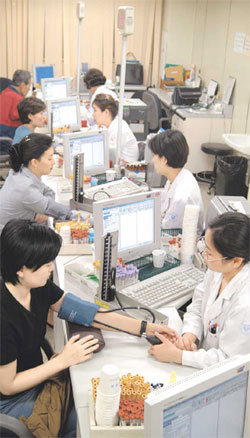Health Checkups: Dont Let the Abnormal Results Scare You
Health Checkups: Dont Let the Abnormal Results Scare You
Posted September. 05, 2004 22:01,

With the arrival of autumn and the time for getting ones body into shape once more after the exhaustion of summer, more and more people are visiting health checkup centers.
The checkups involve hours upon hours of tests, but the doctors explanation of the results often last less than 10 minutes. Its a big letdown. Even worse, the table of results is chock full of virtually indecipherable medical jargon.
But even if the results show abnormalities, theres no reason to be too alarmedtheres a good chance that its caused by factors other than illness.
▽ Could It Be Cancer? Dont Jump to Conclusions
Its natural to be alarmed when you hear that your tumor marker levels are outside normal range. But an abnormal level of tumor markers does not always indicate the existence of cancer.
Prostate-specific antigen (PSA) is an indicator of early stages of prostate cancer. But PSA levels also rise when the prostate is enlarged or infected. If the results show levels of 5 or higher, cancer is suspected and an ultrasound is required.
Carcinoembryonic antigen (CEA), which is used to detect colon cancer and lung cancer, also increases when there is a gastric or duodenal ulcer, or even a case of enteritis (infection in your intestines). Smokers tend to exhibit high levels of CEA as well. When CEA levels exceed 10, further tests such CT scans and colonoscopies are necessary.
CA-125, which indicates ovarian cancer, can exhibit high levels as a result of pregnancy or an infection inside the uterus. However, if a lump has been found, you need to undergo regular screenings to determine whether surgery will be required.
If a CT scan or ultrasound shows a lump, the immediate reaction is to think of cancer. But lumps are common occurrences in the liver, kidneys, thyroid gland, etc., so its sufficient to keep a close watch. If a tumor rather than a lump is suspected, a biopsy is the next course of action.
▽ High blood pressure? Blood in your urine?
During a medical checkup, you tend to be physically and mentally tense because of hunger and apprehension; this often leads to increased blood pressure in your results. Specialists even warn that being prescribed blood pressure-lowering drugs through misdiagnosis is a common problem. If your blood pressure turns out to be higher than normal, you undergo a second test in a more composed and comfortable state.
If the retest still indicates high blood pressure, you are instructed to take your own blood pressure at home using a home blood pressure monitor. There are frequent cases where the patient in question gets so nervous whenever he or she comes to the hospital that their blood pressure shoots upa condition known as white coat hypertension. If home-administered tests continue to show high numbers, further testing becomes necessary.
Finding traces of blood in the urine is no uncommon occurrence either, but the odds of such a result indicating bladder cancer are less then 1 percent. Smokers can temporarily show blood mixed in their urine. Even something as harmless as a light knock to ones side or excessive exercising on the day of the test can lead to the same result.
In the case of women, blood in the urine can point to a bladder infection caused by bacteria. If protein is detected, detailed tests on your kidneys need to be conducted.
▽ Problems with your liver?
There are about 10 categories in liver-function testing. Showing unusual levels in even a single category is designated as a liver function abnormality, but this rarely denotes actual disease.
The most commonly found result is an elevated level of total bilirubin, also known as jaundice level. Bilirubin is a brownish-yellow substance found in bile and is increased by acute hepatitis. But it also increases when youre on an empty stomach, so bilirubin levels alone do not conclusively indicate the existence of liver disease. Additional testing is needed only if other liver-function indicators also exhibit high levels.
GOT (AST) and GPT (ALT), known as fatty liver levels, react most sensitively to acute damage of the liver cells. But if there are no other irregularities such as hepatitis while showing up to 200 percent of normal levels, such results are generally unproblematic. If an obese person shows levels of 70 or higher, he or she must begin exercise and weight-control.
Nearly 30 percent of those who receive checkups show abnormalities in their liver test results, but only 1 percent of such results are related to liver disease.
(Information and assistance provided by: Prof. Park Jin-ho, Family Medicine, and Prof. Park Min-jeong, Internal Medicine, at the Seoul National University Hospital; Prof. Choi Yun-ho, Internal Medicine, at the Samsung Medical Center, Seoul)
TK Sohn sohn@donga.com







